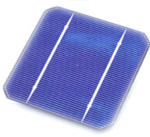|
The Photovoltaic Cell
A solar cell or photovoltaic cell converts sunlight directly into electricity by the photovoltaic effect The photovoltaic cell is the smallest building block for a solar panel. First Generation Solar CellsMost commercially available solar panels are using first generation cells. Mostly, silicon based wafers, monocrystaline or polycrystaline silicon wafers. These cells are expensive to manufacture for the following reasons:
Second generation cells were developed to reduce the production cost. They utilize more cost effective manufacturing techniques, and they are expected to spread into the commercial markets in the next decade. They are mostly based on thin film production process. Early products started to roll into the market in 2008/2009 Cells can be compared by:
Second Generation Solar CellsAt present, the second generation solar cells efficiency is not as good as this of the first generation cells. Therefore to produce the same power the second generation cell is bigger than the first generation cell. The cost per watt of the second generation cell is however lower than the cost of the first generation cell. Third Generation Solar CellsThird generation cells are emerging from research laboratories, there are different ways the research goes. Researchers are trying to achieve comparable efficiency to first generation cells with production cost similar to the one achieved for the second generation cost. Thin film solar cells matured lately, they exhibit lower production cost and good enough efficiency. Micro-invertersMicro-inverters is a new approach in which small DC to AC inverters are allocated individually to each solar module. The overall performance (combined efficiency of the solar panels and inverter) is better, this approach overcomes many drawbacks associated with the concept of one MPPT solar inverter serving the entire array of panels. You can find a good technology review in the WEB site of SolarEdge. return from photovoltaic cell page to the residential solar power page click here to return to my home energy Home Page
|
This site for sale, affordable price
click to contact me for details

click to search the content on this site







